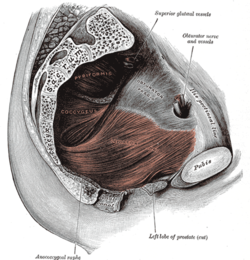 Okay I’ve had a lot of questions relating to pelvic floor issues the last few weeks. Some of these women are incredibly young, some of these women have never had children and some are incredibly fit. Other women think they have strengthened their pelvic floor only to find that one day their laughing with a group of friends one moment and then within a few minutes deliberating – what on earth are they are going to do about their very wet nickers.
Okay I’ve had a lot of questions relating to pelvic floor issues the last few weeks. Some of these women are incredibly young, some of these women have never had children and some are incredibly fit. Other women think they have strengthened their pelvic floor only to find that one day their laughing with a group of friends one moment and then within a few minutes deliberating – what on earth are they are going to do about their very wet nickers.
Before I lose all male readers – please note Pelvic Floor Issues are not solely experienced by females. Men can also develop pelvic floor issues.
So let’s get down to detail.
What is the Pelvic Floor?
The pelvic floor is a large sheet of muscles between your legs, from your pubic bone at the front to your tailbone between your buttocks. These muscles help keep in place your bladder, vagina, uterus and bowel, additionally they help to control the function of these organs.
Any woman who has given birth knows the power of her pelvic floor or the lack there of. For example when you sneeze in those first few days after labour and you feel like your pelvic floor hits the ground. Or when you have to do that first dreaded pooh after giving birth and you pray to God that your insides don’t fall right out into the toilet. That’s when you know you desperately know the power of your pelvic floor.
How do pelvic floor problems occur?
Pelvic floor problems can occur when the pelvic floor muscles are stretched, weakened or too tight.
Some people have weak pelvic floor muscles from an early age possibly due to ongoing digestive issues and constipation. While others notice problems after certain life stages such as pregnancy, childbirth or menopause.
Pelvic floor muscles can be affected by many things including:
- ongoing constipation and straining to empty the bowels
- a chronic cough or sneeze, including those linked to asthma, smoking or hayfever
- heavy lifting (e.g. at work or the gym)
- a history of back pain
- being overweight, obese or having a body mass index (BMI) over 25
- previous injury to the pelvic region (e.g. a fall, surgery or pelvic radiotherapy),
- being pregnant and having babies
- not keeping them active and strong or through over working them
- growing older
What are the Signs of a Pelvic Floor problem?
Common signs that can indicate a pelvic floor problem include:
- accidentally leaking urine when you exercise, laugh, cough or sneeze
- needing to get to the toilet in a hurry or not making it there in time
- difficulties emptying the bladder and/or a sensation of incomplete emptying
- constantly needing to go to the toilet
- getting up to go to the toilet in the night often
- constipation and finding it difficult to empty your bladder or bowel
- accidentally losing control of your bladder or bowel
- accidentally passing wind
- a prolapse
- in women, this may be felt as a bulge in the vagina or a feeling of heaviness, discomfort, pulling, dragging or dropping
- in men, this may be felt as a bulge in the rectum or a feeling of needing to use their bowels but not actually needing to go
- a feeling of heaviness, or dragging in the pelvis or vagina.
- pain in your pelvic area – lower abdomen, groin, scrotum, penis, vulva or vagina
- painful sex
- Pain with sexual intercourse or difficulty with penetration
- Reduced sensation with sexual intercourse
- Erectile and premature ejaculation difficulties
There are two main types of incontinence known as Stress (where small amounts of urine leak during activities) and Urge (a sudden strong urge to pass urine which can lead to a loss of urine).
While a Pelvic Organ Prolapse (POP) is estimated to affect up to 50% of women who have given birth. A prolapse occurs when the tissues that hold the organ in place become weak or stretched – this results in a drop (prolapse) of the organs from their normal position. Once the pelvic muscles become weak they can sag and even lead to a prolapsed vagina.
Exercises to Help Strengthen Your Pelvic Floor.
Unfortunately many people with bladder control problems don’t seek help as they are either embarrassed or they believe nothing can be done. There are many treatment options available so it’s important you seek help from a doctor, a pelvic floor physiotherapist, chiropractor or a practitioner who can explain how to perform these exercises. Pelvic floor exercises can also be very beneficial for both treating and preventing future problems. Here are two simple exercises.
Exercise Number 1
The simplest exercise involves stopping the flow of urine when you are going for a wee.
If you repeat this exercise 10-15 times in a row, you can gradually increase the length of your holds.
Exercise Number 2
Start in a comfortable position, preferably lying down, and breathe normally whilst doing these exercises.
Your pelvic floor muscles run around your urethra, vagina and anus. When you contract these muscles, you should feel a tightening and lifting up inside. Imagine you are trying to “zip up the fly of your pants”using these muscles.
Tighten your pelvic floor and try to hold for three seconds. Rest for six seconds and repeat three times. This would be considered one exercise session. Focus on prioritising five exercise sessions per day.
You can increase the difficulty by increasing the number of repetitions and the seconds you can hold. Try to build up to doing eight reps of eight seconds and five short contractions. This may take 3–4 months to gain sufficient strength.
What Else Can I Do?
Incontinence can also be helped by choosing lifestyle habits. This includes appropriate and regular exercise, including strengthening the core, drinking adequate fluid – preferably water, eating healthy simple foods and practicing good toilet habits (such as emptying your bladder and bowels using correct positioning and technique, without straining and avoiding constipation).
Another critical component to remember is that our body needs its computer (the brain and nervous system) to be communicating clearly to co-ordinate proper organ function. Amongst other things our nervous system helps govern digestion and bowel and bladder habits, so an integral step to sustaining a healthy, vibrant body is to make sure your nervous system is being both efficient and effective in its communication. I encourage you to find a recommended wellness chiropractor near you.
For more information, please see Well Adjusted Babies 2nd Edition.
. . . . .
 Yours in health…
Yours in health…
<Jennifer Barham-Floreani
Bach. Chiropractic, Bach. App Clinical Science
Registered internationally, no longer practicing as a chiropractor in Australia.




